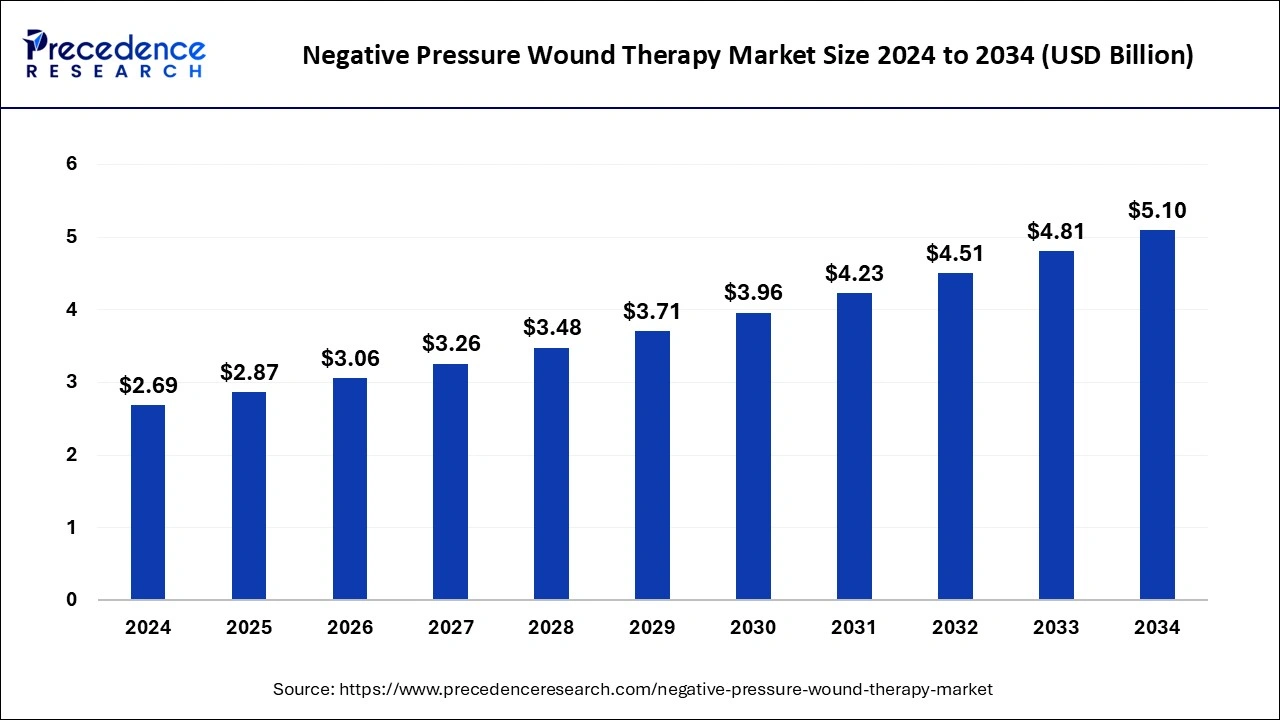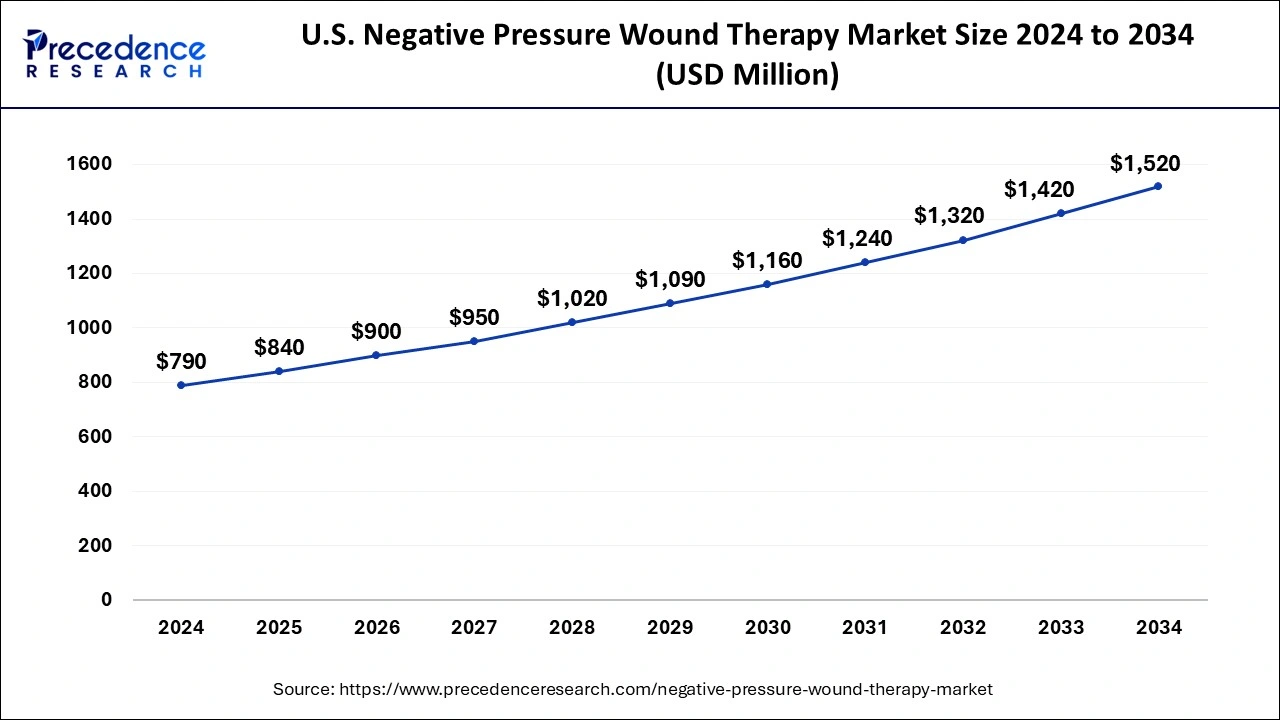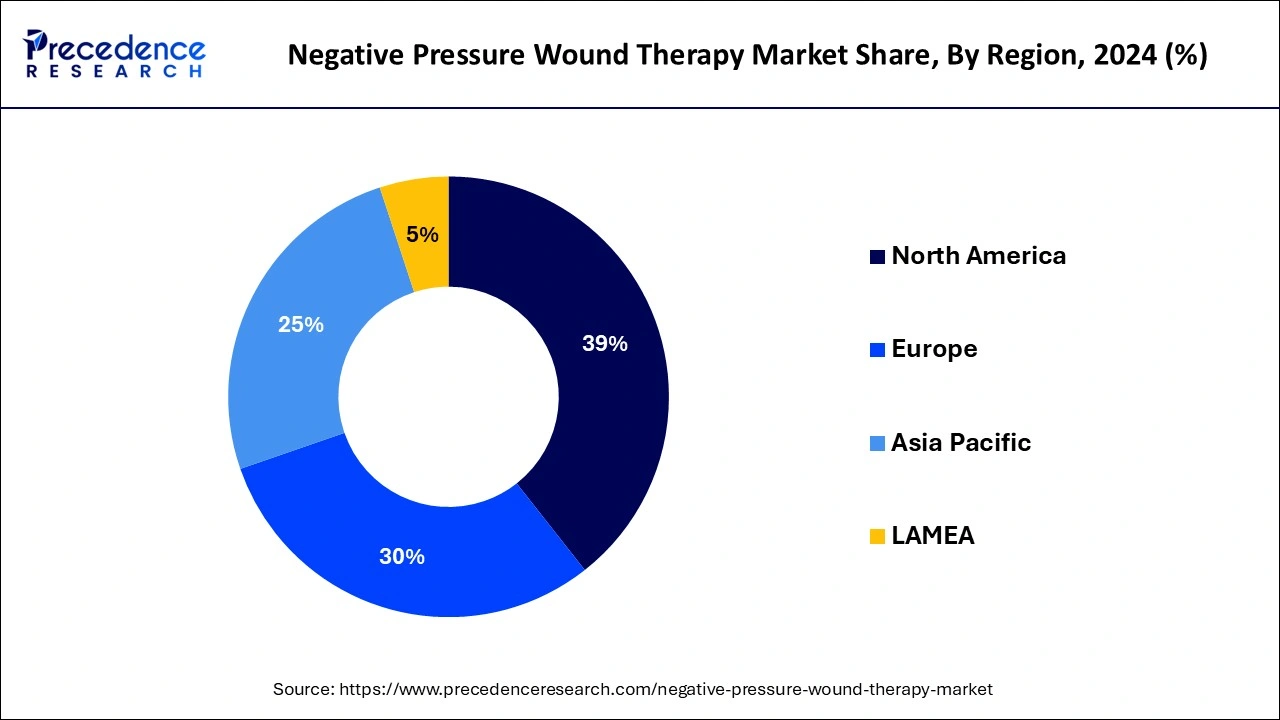January 2025
The global negative pressure wound therapy market size is calculated at USD 2.87 billion in 2025 and is forecasted to reach around USD 5.10 billion by 2034, accelerating at a CAGR of 6.61% from 2025 to 2034. The North America negative pressure wound therapy market size surpassed USD 1.05 billion in 2024 and is expanding at a CAGR of 6.64% during the forecast period. The market sizing and forecasts are revenue-based (USD Million/Billion), with 2024 as the base year.
The global negative pressure wound therapy market size was estimated at USD 2.69 billion in 2024 and is predicted to increase from USD 2.87 billion in 2025 to approximately USD 5.10 billion by 2034, expanding at a CAGR of 6.61% from 2025 to 2034. There are many benefits of using NPWT such as promoting a moist wound healing environment, facilitating the growth of new tissue, improving blood circulation in the wound bed, reducing swelling, etc which contribute to the growth of the market.

The U.S. negative pressure wound therapy market size was estimated at USD 790 million in 2024 and is predicted to be worth around USD 1,520 million by 2034, growing at a CAGR of 6.76% from 2025 to 2034.

North America dominated the negative pressure wound therapy market in 2024. Negative pressure wound therapy is widely used in the North American region. The rising senior population and rising hospitals lead to the growth of the market. Negative pressure wound therapy is commonly provided with V.A.C. (Vacuum Assisted Closure) KCI, TX, USA system using a sealed open-spore gauze or spore, which is now commonplace in trauma and orthopedic departments. The majority of U.S. military casualties with wounds appeared in the United States with negative pressure wound therapy (NPWT) devices in place. In the Canadian community healthcare settings, single-use or disposable negative pressure wound therapy devices are used for the treatment. These factors help to the growth of the market in this region.

Asia Pacific is estimated to be the fastest-growing during the forecast period of 2025-2034. China is the leading country in the demand for advanced wound care technologies. The Chinese herbal medicines put together with negative pressure wound therapy (NPWT) may effectively functionally promote wound healing, shorten disease course in patients, and reduce inflammation. These factors help to grow the negative pressure wound therapy market in this region.
The negative pressure wound therapy market includes a segment of the advanced wound care industry focused on the production, distribution, and sales of negative pressure wound therapy (NPWT) devices. Negative pressure wound therapy (NPWT) is used to improve the physiology of wound healing by the application of sub-atmospheric pressure to promote granulation tissue and reduce inflammatory exudate. It is used to treat difficult wounds that are at risk of non-healing, like skin grafts or diabetic foot ulcers. The benefits of negative pressure wound therapy (NPWT) include minimization of inflammation, easy growth of new tissue, and support for wound closure. It helps to improve blood circulation, reduces swelling, stimulates antibacterial actions by preventing infections, drains excess fluid from the wound bed, improves quality of life, nursing costs savings, less necessity of surgeries, less wound dressing changes, and earlier hospital discharge.
| Report Coverage | Details |
| Growth Rate from 2025 to 2034 | CAGR of 6.61% |
| Market Size in 2025 | USD 2.87 Billion |
| Market Size by 2034 | USD 5.10 Billion |
| Largest Market | North America |
| Base Year | 2024 |
| Forecast Period | 2025 to 2034 |
| Segments Covered | By Product Type, By Wound Type, and By End-use Type |
| Regions Covered | North America, Europe, Asia-Pacific, Latin America, and Middle East & Africa |
Rising senior population
In the senior population, there is a prevalence of pressure ulcers, also known as pressure sores, bedsores, and decubitus ulcers. These are localized injuries to the underlying structures or the skin that need negative pressure wound therapy for treatment. In the senior population, incidents and prevalence rates are high because of multifactorial risk factors like physiological changes, medications affecting the skin, nutritional habits, changes in functional status, and comorbidities. As the senior population increases, the prevalence of chronic diseases also increases. Senior individuals are more open to chronic diseases, including heart disease, cancers, and diabetes. These factors help to the growth of the negative pressure wound therapy market.
Contraindications and complications of the negative pressure wound therapy (NPWT)
Negative pressure wound therapy may be unsuitable for some wounds, including wounds because of skin cancer, inflamed bones (Osteomyelitis), eschar, dead or necrotic tissue that has not been cleaned, and tunnels or fistulas to body cavities and organs. The disadvantages of negative pressure wound therapy include initial pain because of the application of a negative pressure wound therapy device, and it is necessary to connect to the unit for a day at least 22 hours. The non-healing wound can require potentially more intrusive treatment than negative pressure wound therapy, and the therapy is not always effective. These complications may restrict the growth of the negative pressure wound therapy market.
Advanced technologies
Improvement in the negative pressure wound therapy for wound healing encouragements in orthopedic and traumatic wounds. Use of NPWTi-d (Negative pressure wound therapy instillation and dwell time for the management of orthopedics and traumatic wounds that provides unique challenges. Development of its applications and cost-effective analysis are guidelines based on randomized and longitudinal controlled research trials. These factors help to the growth of the negative pressure wound therapy market.
Use of disposable and portable models
The use of disposable and portable models for negative pressure wound therapy has many benefits, including minimizing risks of infections and eliminating the necessity of sterilizations, maintenance, and cleaning. Lack of manpower and time for healthcare sectors to reprocess medical products, which is helpful for healthcare professionals to use disposable and portable models. Disposable devices save healthcare professionals time and effort. Portable models help patients to take treatments at home. These factors are helpful for the growth of the negative pressure wound therapy market.
The conventional NPWT devices segment dominated the market in 2024. In conventional NPWT-type devices, foam dressing is placed above the wound, which is sealed with impervious and an adhesive film and is connected to a vacuum pump, which creates negative pressure and removes air from the dressing. Conventional NPWT devices are ideal for deep, large wounds or heavily exudating wounds as they may manage fluid which is in large amounts. The adoption of conventional NPWT devices is increasing globally. It is useful for reducing costs and helps with earlier hospital discharges. These factors help to the growth of the segment and contribute to the growth of the negative pressure wound therapy market.
The single-use NPWT devices segment is expected to grow the fastest during the forecast period. The single-use NPWT devices are disposable, lightweight, and smaller. This device provides an effective and safe alternative to conventional negative pressure wound therapy. It helps to reduce complication rates of closed surgical incisions and provides healing of select open wounds. These devices are designed for home care use, and they can be used for primary treatment options. These factors help to the growth of the segment and contribute to the growth of the negative pressure wound therapy market.
The chronic wounds segment dominated the market in 2024. In the chronic wound type, negative pressure wound therapy is used. This inflamed wound or chronic wound type is regularly cleaned by healthcare professionals who remove infected or dead tissue also and the treatment is known as debridement. Chronic wounds include infected cuts, large burns, deep ulcers, pressure ulcers, diabetic ulcers, arterial ulcers, and venous ulcers. For these certain wounds negative pressure wound therapy is recommended. These factors help to the growth of the segment and contribute to the growth of the negative pressure wound therapy market.
The acute wounds segment is estimated to be the fastest growing during the forecast period. When acute wounds are not covered or closed by primary intention because of swelling or skin tension, active infections, and risk of infections, negative pressure wound therapy is recommended for treatment. Acute wounds include traumatic burns or injuries and surgical incisions. The use of negative pressure wound therapy for acute wounds has grown increasingly popular. These factors help to the growth of the segment and contribute to the growth of the negative pressure wound therapy market.
The hospitals segment dominated the negative pressure wound therapy market in 2024. Negative pressure wound therapy is used for the treatment of complex wounds and is now commonplace in outpatient and various clinical settings and hospitals. The use of negative pressure wound therapy in hospitals is because of the duration of the treatments, size of the wounds, number of debridements, and length of hospital stays. In hospitals for acute wound and chronic wound treatment purposes, negative pressure wound therapy is used. These chronic wound and acute wound types are the key factors for the use of this therapy in hospitals. An increasing number of hospitals leads to growth in the market. These factors help the growth of the segment and contribute to the growth of the market.
The home healthcare end-use type segment is expected to grow the fastest during the forecast period. Negative pressure wound therapy is a portable device that is used for patients to heal at home. Mostly for patients who suffer from chronic disease, there is a high use of home-based healthcare negative pressure wound therapy. In diabetic wound salvage and peripheral artery disease, there is the use of home-based negative pressure wound therapy. It is also helpful for the chronic and acute diseases. This home-based negative pressure wound therapy minimizes the risks of hospitalization. These factors help to the growth of the segment and contribute to the growth of the negative pressure wound therapy market.
By Product Type
By Wound Type
By End-use Type
By Geography
For inquiries regarding discounts, bulk purchases, or customization requests, please contact us at sales@precedenceresearch.com
No cookie-cutter, only authentic analysis – take the 1st step to become a Precedence Research client
January 2025
August 2024
December 2024
September 2024